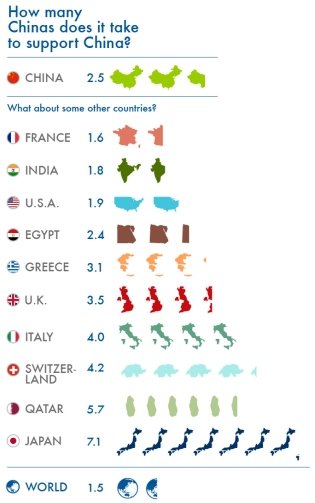 Oakland, California, USA – Humanity exhausted nature’s budget for the year on August 20 and is now operating in overdraft, according to data from Global Footprint Network, an international sustainability think tank with offices in California, Europe and Japan.
Oakland, California, USA – Humanity exhausted nature’s budget for the year on August 20 and is now operating in overdraft, according to data from Global Footprint Network, an international sustainability think tank with offices in California, Europe and Japan.
Earth Overshoot Day is the approximate date humanity’s annual demand on nature exceeds what Earth can renew in a year. Global Footprint Network tracks humanity’s demand on the planet’s ecological resources (such as food provisions, raw materials and carbon dioxide absorption) – it’s Ecological Footprint – against nature’s ability to replenish those resources and absorb waste. Global Footprint Network’s data show that, in less than eight months, we have used as much nature as our planet can regenerate this year.
The rest of the year corresponds to overshoot. We will maintain our ecological deficit by depleting stocks of fish, trees and other resources, and accumulating waste such as carbon dioxide in the atmosphere and oceans. As our level of consumption, or “spending”, grows, the interest we are paying on this mounting ecological debt – shrinking forests, biodiversity loss, fisheries collapse, food shortages, degraded land productivity and the build-up of carbon dioxide in our atmosphere and oceans – not only burdens the environment but also undermines our economies. Climate change – a result of greenhouse gases being emitted faster than they can be absorbed by forests and oceans – is the most wide-spread impact of ecological overspending.
In 1961, humanity used only about two-thirds of Earth’s available ecological resources. Back then, most countries had ecological reserves. Yet both global demand and population are increasing. In the early 1970s, increased carbon emissions and human demand for resources began outstripping what the planet could renewably produce. We went into ecological overshoot.
“Facing such constraints has direct impacts on people. Lower-income populations have a hard time competing with the rest of the world for resources,” said Mathis Wackernagel, President of Global Footprint Network and the co-creator of the Ecological Footprint resource accounting metric.
 Preparing for the Future is in National Self-Interest
Preparing for the Future is in National Self-Interest
Global Footprint Network’s 2012 National Footprint Accounts show humanity is now using ecological resources and services at a rate it would take just over 1.5 Earths to renew. We are on track to require the resources of two Earths well before mid-century.
China’s total Ecological Footprint is the world’s largest, primarily because of its large population. China’s per capita Footprint is far smaller than those of countries in Europe or North America, but for the past seven years, it has exceeded what is available per person worldwide. Indeed, if everybody were to live like the typical resident of China, it would take 1.2 Earths to support the global population. Other countries’ per capita demands on the planet’s ecosystems are even higher: If everybody were to live like United States residents today, it would take four Earths to support the global population. In Qatar, the typical resident requires the resources of six and a half Earths.
While the global recession that began in October 2008 slowed humanity’s demand for resources, our consumption continues to rise. To avoid economic hardship, resource limits must be at the core of decision-making. Current resource trends already cannot meet the needs of the planet’s 7 billion – and growing – population. About two billion people lack access to the resources required to meet their basic needs.
Today, more than 80 percent of the world’s population lives in countries that use more than their own ecosystems can renew. These “ecological debtor” countries either deplete their own ecological resources or get them from elsewhere.
Ecological debtors are using more than they have within their own borders. Japan’s residents consume the ecological resources of 7.1 Japans. It would take four Italys to support Italy. Egypt uses the ecological resources of 2.4 Egypts.














